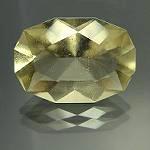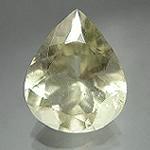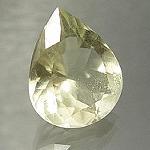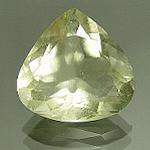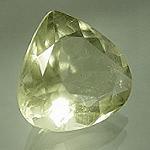|
ClassicGems.net |
|
|
 |
|
Libyan Desert Glass (variety of Tektite) |
|
Discovered in 1932; IMA status: Not Valid (trade name) |
|
|
|
Chemistry |
|
|
|
|
|
SiO2 (95% Silica + Al,Ca,Fe,K,Mg,Mn,Na,Ti) |
|
|
|
Silicon Dioxide + various impurities |
|
|
|
|
Classification |
|
|
|
|
|
Mineraloid (not a true mineral) |
|
|
Varieties: |
None |
|
Synonyms: |
Libyan Desert Silica, Libyan Glass, Libyan Silica Glass |
|
|
|
|
Crystal Data |
|
|
|
|
|
Amorphous (natural glass) |
|
|
None |
|
|
None |
|
|
|
|
|
Physical Properties |
|
|
|
|
|
Poor/indistinct, none |
|
|
Conchoidal, Sub-conchoidal |
|
|
Brittle |
|
|
6.5 - 7.0 |
|
|
2.20 - 2.65 (g/cm3) (estimated) |
|
|
Not Fluorescent |
|
|
Not Radioactive |
|
|
|
|
|
Optical Properties |
|
|
|
|
|
Yellow, pale yellow, almost colorless |
|
|
Transparent to Translucent |
|
|
Vitreous |
|
|
|
|
|
Occurances |
|
|
|
|
|
Geological Setting: |
Strewnfield/impact site |
|
Common Associations: |
None |
|
Common Impurities: |
Al, Ca, Fe, K, Mg, Mn, Na, Ti, air or gas bubbles |
|
Type Locality: |
Libyan Desert Glass Area, Great Sand Sea, Western Desert, Egypt |
|
Year Discovered: |
1932 |
|
View mineral photos: |
|
|
|
|
|
More Information |
|
|
|
|
|
|
Mindat.org
(Libyan Desert Glass) |
|
|
|
|
Libyan Desert Glass is usually a beautiful straw yellow or champagne yellow. It is a Tektite material found in the Western Desert of Egypt near the Libyan border (part of the Great Sand Sea). The occurance of this silica-glass was first documented by Patrick A. Clayton in 1932. Libyan Desert Glass is named after the Libyan Desert although its discovery location is actually in the Western Desert of Egypt. It is called "glass" because it is a natural glass made of fused silica. The major component of Libyan Desert Glass is Lechatelierite, a naturally fused, X-ray amorphous, almost pure type of silica. Lechatelierite forms on impact of meteorites as a result of sand melting. It also forms when lightning strikes sand or other very SiO2-rich sediments and rocks. Lechatelierite is a mineraloid as it is amorphous and does not have a crystalline structure. Although not a true mineral, it is often classified in the Quartz mineral group. Quartz is also made of silica, but it has a crystalline structure. Lechatelierite is named after Henry Louis Le Chatelier (1850-1936), French-Italian chemist. Until recently, Libyan Desert Glass was somewhat controversial. It was suspected to be a Tektite similar to Moldavite, but was not associated with any meteor crator or impact zone. Researchers at the Center for Remote Sensing at Boston University have recently discovered a very large impact crater in Egypt 31km in diameter which seems to coincide with the formation of Libyan Desert Glass. This crater has been named the Kebira Crater. The association of Libyan Desert Glass with this newly discovered crater is tentative and further research still needs to be done. Libyan Desert Glass is similar to other Tektites such as Moldavite and Indochinites. Tektites may be Meteoric Silica Glass as a result of the impact of a meteor on Earth. Tektites are usually found in association with meteor impact craters or suspected ancient craters. Their origin is not fully understood. The leading theory, the "Meteorite Impact Theory", is that when a meteorite hits the Earth, the heat and pressure of the impact are so great that it causes rock and sand to be fused into glass or Tektites. Tektites, like all natural glasses, contain gas bubbles and "swirl" like inclusions. |
|
|
Libyan Desert Glass gems for sale:
|
|||||||||||||||||||||||||||||||||||||||||||||||||||||||||||||||||||||||||||||||||
